[Click on BLUE links for sources and more information]
sin maíz no hay país—without corn, there is no country
Americans love Mexican food. We consume nachos, tacos, burritos, tortas, enchiladas, tamales and anything resembling Mexican in enormous quantities. We love Mexican beverages, happily knocking back huge amounts of tequila, mescal, and Mexican beer every year. We love Mexican people—we sure employ a lot of them. Despite our ridiculously hypocritical attitudes towards immigration, we demand that Mexicans cook a large percentage of the food we eat, grow the ingredients we need to make that food, clean our houses, mow our lawns, wash our dishes, and look after our children.
Anthony Bourdain, Bourdain’s Field Notes: Mexico
Anthony Bourdain’s perceptions of Mexico and its people are spot on. His Field Notes on Mexico are worth reading in their entirety and so is his article Can Mexican Corn Be Saved? You may wonder why Mexico’s corn needs to be saved. In this era of disputes over borders and immigration, it turns out that the history, politics and economics of corn provides many of the answers. Here are a few facts.
NAFTA, U. S. subsidies, and changes in Mexican and U.S. Government corn policies have disadvantaged Mexico’s indigenous farmers and forced many off their farms. Many of these Mexican farmers traveled north to find jobs. Mexico has lost about 2 million agricultural jobs since NAFTA was passed in 1994. John Vaillant in his fine novel The Jaguar’s Children has a passage that clearly explains the irony in what has happened to Mexico.
A few of us students were worried about these transgénicos coming into Mexico, not as food but as seed, because that corn is all the same—the diversity is gone so one disease can kill it. It’s happened before and we didn’t want some corn invented in a lab last year to be mixing with native maize that has taken thousands of years to develop. But NAFTA and the Mexican government allowed SantaMaize into Mexico—only in the north, they said, on an experimental basis, but that’s like saying migrantes will only work in Texas. Corn is a migrante too. So we put together a petition calling for a moratorium on GMO corn. The problem for us is that NAFTA isn’t interested in some indio with a little milpa of one hectare growing native corn and taking a bag to market a couple times a year. NAFTA wants big farms and all the same corn—lots and lots, all the time, and this is who our government is subsidizing now, not the campesino. They’re telling us to leave the pueblos and work in the maquiladoras. Well, would you send your kids to Tijuana or Ciudad Juárez? But Mexicanos want their tortillas, right? They want them right now, and who do you think wants to sell the seed to grow the corn to make all those tortillas? This is the magical realism of NAFTA, Tito—Mexico, the birthplace of corn, is now importing surplus corn from el Norte—millions of tons driving the price down so campesinos can’t afford to grow it. Exporting people and importing corn. It is backwards, no? The Jaguar’s Children, John Vaillant
GMO seeds imported into Mexico from the United States are destroying native varieties of corn that have evolved over centuries. Some varieties are becoming extinct. Mexico still grows and cooks 59 varieties of corn but for how long? In reality there may be hundreds or thousands of variations depending on soil, sun, water and other environmental factors. Corn depends on the terroir just like wine or mezcal.
It’s ridiculous for a country like Mexico whose people are often hungry to use its best land to grow produce for a country where food is so abundant that its people are obese … cheap corn has driven the growth of animal feedlots, sewage concentration and water and air pollution … This genetic diversity, the product of 10,000 years of human-maize co-evolution, represents some of the most precious and irreplaceable information on Earth, as we were reminded in 1970 when a fungus decimated the American corn crop and genes for resistance were found in a landrace in southern Mexico. Michael Pollan
Mexico’s native corn varieties (landraces) evolved over centuries to grow in diverse conditions including rugged mountainous terrain and steamy swamplands. These unique corn varieties may prove extremely valuable as the impacts of global warming increase. One type of corn in southern Mexico actually makes its own fertilizer. It is cheaper to grow and more environmentally sound and may be especially useful in poor countries that cannot afford commercial fertilizer.
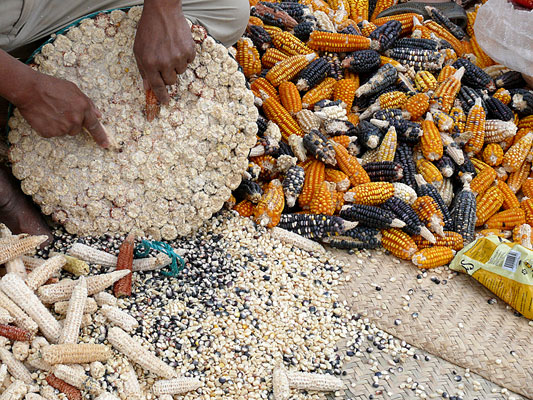
Photo courtesy of Chris Stowens, Oaxaca – The Year After
Tortillas are at the very heart of Mexican cuisine. As one who loves to cook and learn about food and its preparation, I have gotten quite an education about corn. It is a very big deal here and transgenico corn is a major political issue. There are literally thousands of varieties of corn here. In certain villages there may be as many as 26 different varieties growing, each dependent on differing amounts of sun, soil condition, etc. Having lots of different varieties helps the plants to be more insect and disease resistant. Chris Stowens, Oaxaca – The Year After
These varieties of corn might at some point save humanity … In the sierra here, there are varieties of corn that grow as high as 3,000 meters,” Gonzalez said, or nearly 10,000 feet. “There are varieties that can be planted in swampy land or that you can plant in semidesert areas. They may not be very productive but they have allowed people to survive. Aldo Gonzalez
America’s largest export may be obesity. GMO corn and corn products together with an American “fast food” mentality have created an obesity crisis not only in Mexico but around the world.
In 1980, 7 percent of Mexicans were obese, a figure that tripled to 20.3 percent by 2016, according to the Institute for Health Metrics and Evaluation at the University of Washington. Diabetes is now Mexico’s top killer, claiming 80,000 lives a year, the World Health Organization has reported. The phenomenon is not limited to Mexico. Research shows free trade is among the key factors that have accelerated the spread of low-nutrient, highly processed foods from the West, “driving the obesity epidemic in China, India, and other developing countries worldwide,” according to the T.H. Chan School of Public Health at Harvard.
Consumers sacrifice both taste and nutritional value as cheap GMO corn replaces the ancient Mexican landraces. Sadly only the rich can now afford the traditional corn products that originated in Mexico and so many Mexicans grew up on. Much of the food that Mexico grows is exported to the United States.
Another fiesta that we have is the fiesta of corn. We give thanks every December 30 to nature, which has given us corn. We are people of corn. We have created our own world, our own gods, and our basic philosophical ideas begin with the cultivation of corn. If you don’t eat corn in Zaachila, then you are not Zachileño. We Are The Face Of Oaxaca, Lynn Stephen
While corn was first cultivated in Mexico thousands of years ago, today Mexico imports much of its corn from the United States although recently Mexico has been exploring other sources in Brazil and Argentina because of the anti-Mexican rhetoric of the current American President.
In the short term, GMO corn may be more productive and cheaper to grow. This has undoubtedly reduced hunger and starvation around the world. But, the long-term costs include a loss of culture, diversity, tradition and jobs that cannot be ignored.
In current political discussions of immigration, it is common to hear “without a border there is no country.” When it comes to corn, many Mexicans would agree. Cheap corn invading Mexico from the United States has changed Mexico, not always in a good way.
The result of all this change, according to Mier, is that 59 varieties of heirloom corn native to Mexico are on the verge of extinction, as are the many regional dishes they are supposed to be made with. Another byproduct is the health issues that have been plaguing Mexico. The substitution of junk food and bad tortillas have had a strong hand in the country’s ranking second-highest in the world for obesity, first for childhood obesity, and as a world leader in diabetes diagnoses. Mier says that if people ate real tortillas made from local corn, a lot of these problems will be alleviated. Anthony Bourdain
Our deep relationship with corn enables us to sustain our families, and it comes with the responsibility that we must treat the corn as we would treat our family. We pray to god when we sow the fields, asking for help in bringing the corn to harvest. Because corn is the giver of life. Corn is our religion. Floriano Garcia Delfín
Masienda is one California company that is making a positive difference for both Mexicans and Americans, We suggest you go to their website and read about what they are doing, how and why. There are so many fascinating stories about corn that we cannot tell them all in our short blog. One thing we do know, however, is that when it comes to Mexico, it’s all about the corn.
Some additional photos of note:
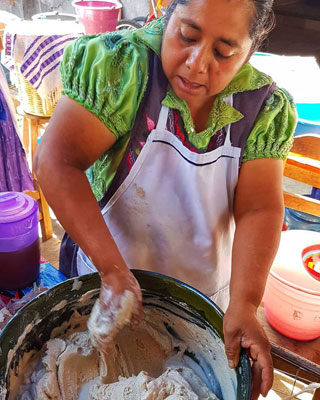
Making Tejate, Photo courtesy of Rene Cabrera, Las Bugambilias Tours
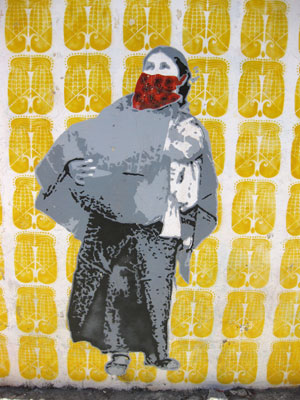
Corn Under Assault, Chris Stowens, Oaxaca – One Year Later
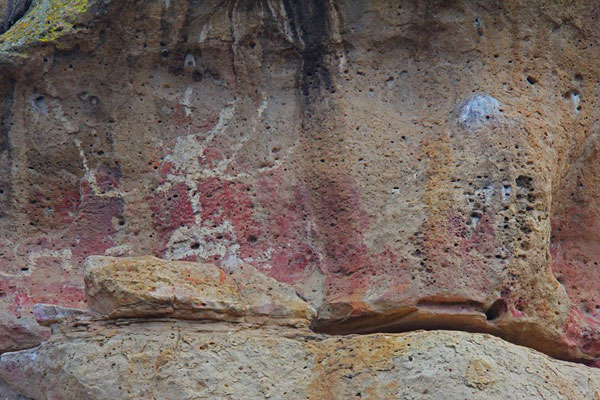
Petroglyph near cave where oldest cultivated corn was found in Oaxaca, Mexico, photo courtesy of Rene Cabrera, Las Bugambilias Tours
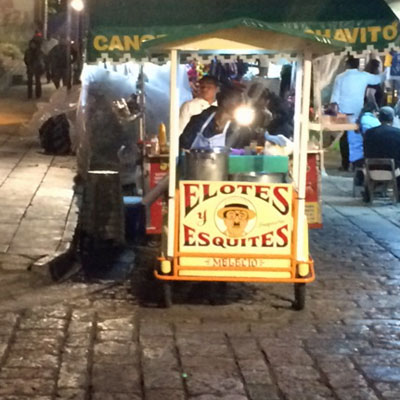
Corn Stand in Oaxaca City near Santo Domingo Church


The smoky delectable aroma of corn tortillas is seared into my memory from a childhood trip to some tiny town way, way south in Mexico, where my mother went to get a quickie divorce from my father.
There you go! A one-sentence short story!
She didn’t go to Reno? How unAmerican. But at least you got real tortillas.
I also have a memory of being way high up on a mountain road with my brother, my mother and her boyfriend (he’s why we were in Mexico!). We got out of the car and peered down, down into a gorge at the twisted wreckage of a big truck. I recall vultures, though they may have been supplied later by my lurid imagination.
No. It was not your imagination. You saw vultures. I know it because I’ve been there too. And, a dead decomposing cow in the stream.